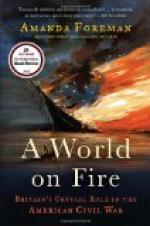[Footnote 672: These facts are drawn from Board of Trade Reports, and from the files of the Economist, London, and Hunt’s Merchants Magazine, New York. I am also indebted to a manuscript thesis by T.P. Martin, “The Effects of the Civil War Blockade on the Cotton Trade of the United Kingdom,” Stanford University. Mr. Martin in 1921 presented at Harvard University a thesis for the Ph.D degree, entitled “The Influence of Trade (in Cotton and Wheat) on Anglo-American Relations, 1829-1846,” but has not yet carried his more matured study to the Civil War period.]
[Footnote 673: Adams, Trans-Atlantic Historical Solidarity, p. 89.]
[Footnote 674: F.O., Am., Vol. 843. No. 10. Bunch to Russell, Jan. 8, 1862. Bunch also reported that inland fields were being transformed to corn production and that even the cotton on hand was deteriorating because of the lack of bagging, shut off by the blockade.]
[Footnote 675: Arnold, Cotton Famine, p. 81.]
[Footnote 676: Richardson, II, 198. Mason to Hunter, March 11, 1862.]
[Footnote 677: Parliamentary Returns, 1861 and 1862. Monthly Accounts of Trade and Navigation (in Parliamentary Papers, 1862, Commons. Vol. LV, and 1863, Commons, Vol. LXV).]
[Footnote 678: Arnold, Cotton Famine, pp. 174 and 215.]
[Footnote 679: In 1861 there were 26 Members from Lancashire in the Commons, representing 14 boroughs and 2 counties. The suffrage was such that only 1 in every 27 of the population had the vote. For all England the proportion was 1 in 23 (Rhodes, IV, 359). Parliamentary Papers, 1867-8, Lords, Vol. XXXII, “Report on Boundaries of Boroughs and Counties of England.”]
[Footnote 680: The figures are drawn from (1) Farnall’s “Reports on Distress in the Manufacturing Districts,” 1862. Parliamentary Papers, Commons, Vol. XLIX, Pt. I, 1863. Ibid., Vol. LII, 1864; and (2) from “Summary of the Number of Paupers in the Distressed Districts,” from November, 1861, to December, 1863. Commons, Vol. LII. Farnall’s reports are less exact than the Summary since at times Liverpool is included, at times not, as also six small poor-law unions which do not appear in his reports until 1864. The Summary consistently includes Liverpool, and fluctuates violently for that city whenever weather conditions interfered with the ordinary business of the port. It is a striking illustration of the narrow margin of living wages among the dockers of Liverpool that an annotation at the foot of a column of statistics should explain an increase in one week of 21,000 persons thrown on poor relief to the “prevalence of a strong east wind” which prevented vessels from getting up to the docks.]
[Footnote 681: Trevelyan, Bright, p. 309. To Sumner, Dec. 6, 1862.]




